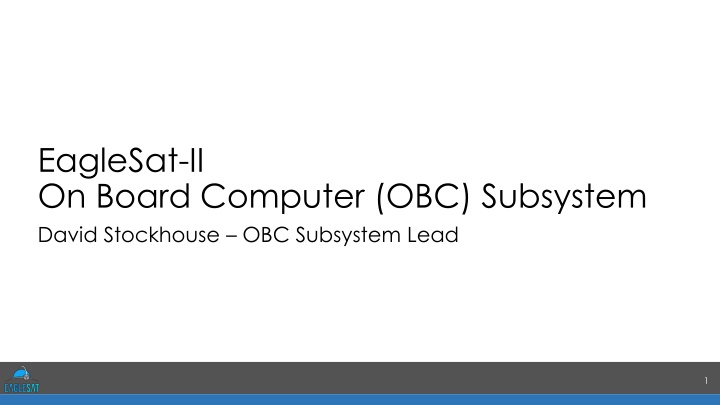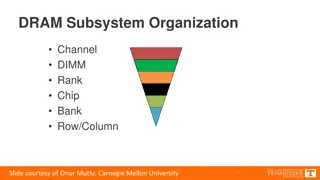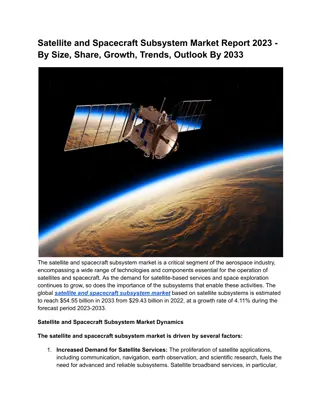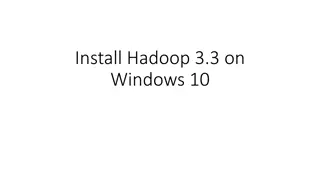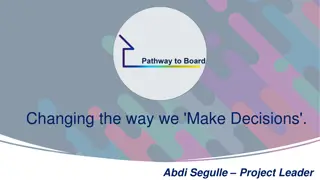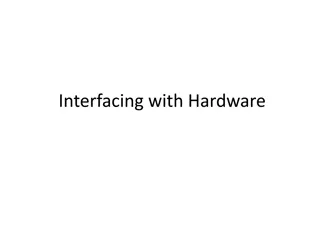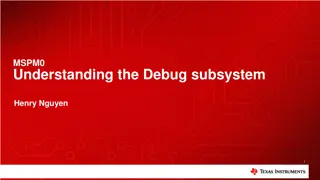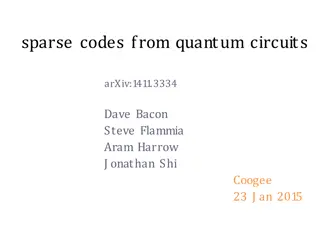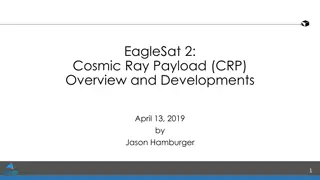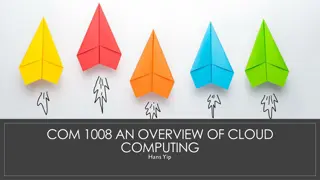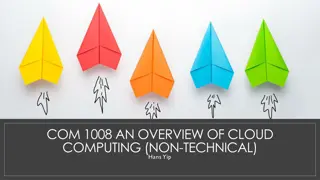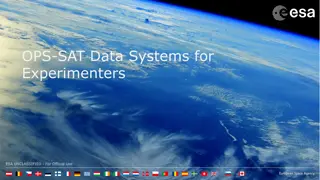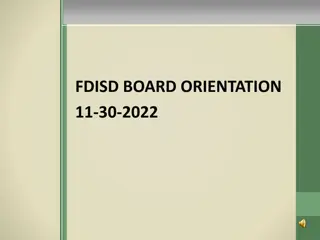EagleSat-II On-Board Computer (OBC) Subsystem Overview
This document provides an overview of the EagleSat-II On-Board Computer (OBC) subsystem, detailing its architecture, system-level block diagram, and the integration of two independent computer systems - Payload computer (TI TM4C MCU and Xilinx Artix-7 FPGA) and Bus computer (GOMSpace Nanomind A3200). It also discusses the ease of development, software considerations, and board design of the Payload computer.
Uploaded on Mar 18, 2025 | 3 Views
Download Presentation

Please find below an Image/Link to download the presentation.
The content on the website is provided AS IS for your information and personal use only. It may not be sold, licensed, or shared on other websites without obtaining consent from the author.If you encounter any issues during the download, it is possible that the publisher has removed the file from their server.
You are allowed to download the files provided on this website for personal or commercial use, subject to the condition that they are used lawfully. All files are the property of their respective owners.
The content on the website is provided AS IS for your information and personal use only. It may not be sold, licensed, or shared on other websites without obtaining consent from the author.
E N D
Presentation Transcript
EagleSat-II On Board Computer (OBC) Subsystem David Stockhouse OBC Subsystem Lead 1
OBC Overview Architecture Description Payload Computer Bus Computer 2
Architecture Description Figure 1: System-Level Block Diagram 3
Architecture Description Two independent computer systems Payload computer (TI TM4C (MCU) + Xilinx Artix-7 (FPGA)) Controls all payload instruments (cameras and RAM) and some telemetry instruments Processes all payload data and reports to bus computer Developed in-house Bus computer (GOMSpace Nanomind A3200) Connects to all other subsystems, including payload computer Processes all bus system data and telemetry Communicates with the ground through COMMS subsystem Commercial off-the-shelf component 4
Payload Stack Figure 2: Payload Subsystem Block Diagram 5
Payload Computer Overview Ease of development for the team critically important Microcontroller + FPGA to meet instrument timing requirements TM4C processor to leverage team experience from coursework Artix-7 breakout to leverage team experience from coursework and ease PCB design Simple software loop with timer interrupt for instrument control Figure 3: EK-TM4C1294XL development kit http://www.ti.com/tool/EK-TM4C1294XL Figure 4: Cmod A7 development kit https://www.xilinx.com/products/boards-and-kits/1-f3zdsm.html 6
Payload Computer Software Ease of development a priority Payload software being developed by each payload subteam independently No need for high-overhead complex solution like RTOS Simple cyclic executive with interrupts 7
Payload Computer Board Design Prototype PCB early in design/build process Parts and interfaces selected, early schematic designs Pin and peripheral assignments planned, subject to change MDE prototype already running on less powerful TM4C Black box test of descaled system during high-altitude balloon flight In processing of migration to flight hardware equivalent CRP prototype in development MCU + FPGA development difficult difficult to test either until both complete 8
Payload Computer Additional Telemetry Bus computer doesn t have any available PC/104 GPIO pins COTS parts limited to what already exists on hardware Payload computer designed in house as many extra interfaces as we want Temperature sensors In-house PCBs can include as many sensors as desired routed to unused PC/104 pins Cubesat I2C bus free for use with mission-critical systems Some unoccupied PC/104 pins can be used for thermal measurements throughout cubesat structure, outside of payload stack ACS patch heater Small PCB close to ACS with power control circuitry Activated by payload computer based on temperature measurements 9
Bus Computer Overview Interfaces with all other bus systems and payload stack Receives and interprets commands from the ground Packetizes data and telemetry for downlink Composed of commercial off-the-shelf (COTS) components Minimize risk from in-house development for mission-critical system Time can be spent testing and validating requirements 10
Bus Computer Hardware GOMSpace NanoMind A3200 + NanoDock DMC-3 NanoDock routes UART between NanoMind and GPS kit CAN and I2C routed to cubesat bus headers Additional debugging and general purpose UARTs available through JST sockets Figure 4: NanoDock with two daughterboards https://gomspace.com/shop/subsystems/docks/nanodock-dmc-3.aspx 11
Bus Computer Flight Software (FSW) GOMSpace software includes integration with FreeRTOS GOMSpace shell (GOSH) for UART debugging during development F Prime Open-source NASA JPL FSW architecture and framework Object-oriented model of the FSW as components linked by ports Provides framework for ease of software development Comes with debugging and testing environments and tools Support porting to FreeRTOS offered from creators at JPL 12
Bus Computer Operating Modes Detumble Entered at every boot, all subsystems off except OBC and ACS ACS detumbling the spacecraft until low rotation rate Safe mode Spacecraft reduced to barebones operation Payloads off, COMMS attempts to establish communication with ground station Normal operating mode Main science mission underway Payloads fully operating, ACS stationkeeping Figure 7: EagleSat-II Operating Modes 13
Questions? 14
